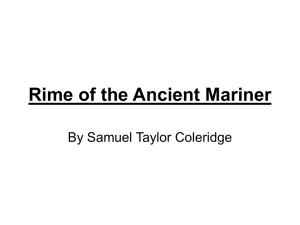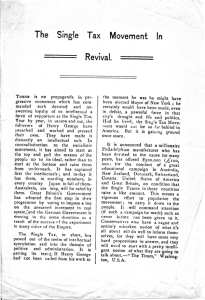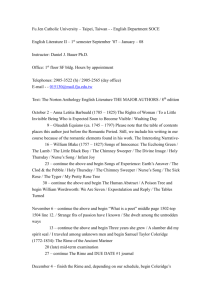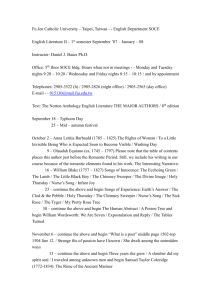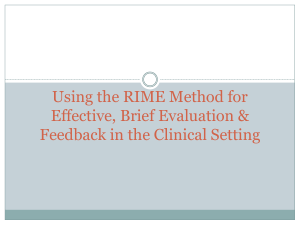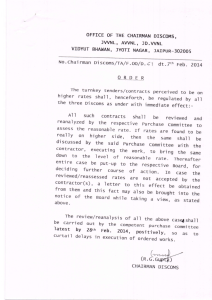ORGANIZING YOUR LIFE THROUGH TIME MANAGEMENT
advertisement
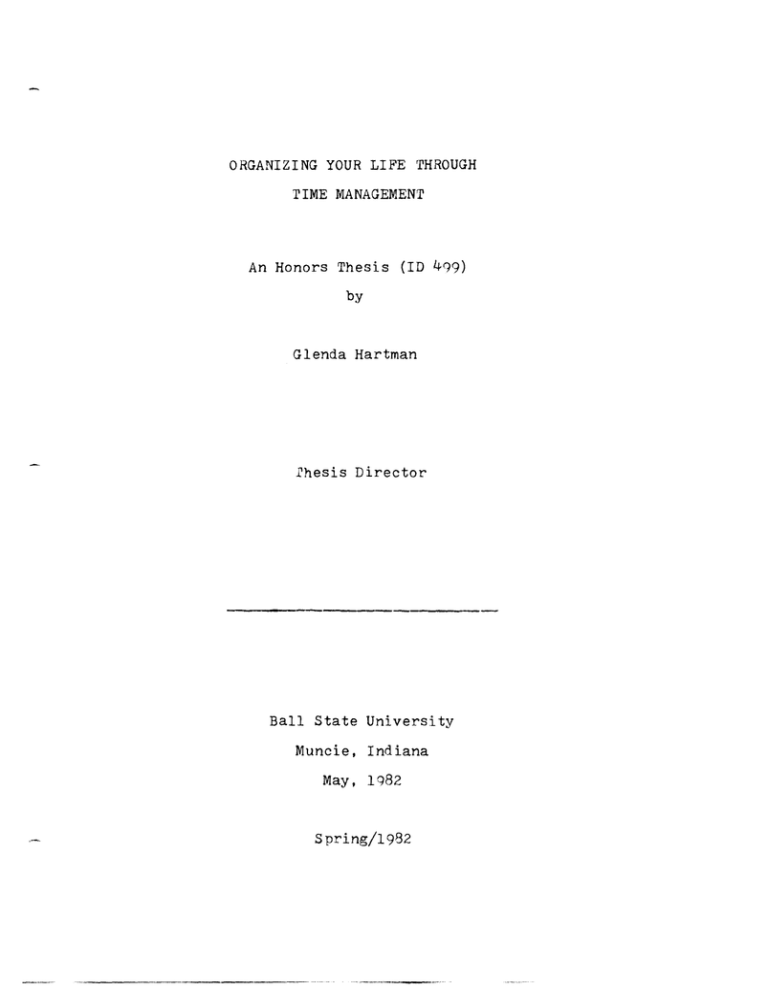
ORGANIZING YOUR LIFE THROUGH
TIME MANAGEMENT
An Honors Thesis (ID 499)
by
Glenda Hartman
fhesis Director
Ball State University
Muncie, Indiana
May, 1982
Spring/1982
, I
Accepted by the faculty of the Honors College, Ball State
University, in nartial fulfillment of the re'1uirements for t:he
Bachelor of Science degree.
__~ :7.~4.L ____ _
Director
Thesis
Department of Business Education
and Office Administration
ftlay 13, 1982
i
ORGANIZING YOUR LIFE THROUGH
TIME MANAGEMENT
I.
II.
III.
IV.
V.
VI.
VII.
Introduction
Identify Time Wasters
A. Visitors
B. Telephone Calls
c. Mail and Other Paperwork
D. waiting Time
E. Shopping
F. Meetings
Set Goals
A. Wants Inventory
B. Life Goals
1. Intellectual ~rowth
2. Family characteristics
3. Physical well-being
C. Job Goals
1. Promotional/achievement
2.
Resnect
3. Effectiveness/Efficiency
Plan Work
A. Planning Areas
B. Internal Prime Time
C. Douglass System
D. Time Log
5. Task Classification
1. Two-dimensional view of tasks to be completed
2. Methodical approach for complex tasks
3. Methodical approach for long-term tasks
Determine Priorities
A. Target Method
B. Timeline Technique
C. Daily Schedule
D. Equipment
E. Priorities Card
Delegate Responsibilities
A. Managerial Responsibility
B. Delegate Choice
Conclusion
ii
ORGANIZING YOUR LIFE THROUGH
TIME MANAGEMENT
William Penn, founder of Pennsylvania: "rime is what we
want most, but what alas we use worse."
Proverb:
saving."
"Every scrap of a wise person s time is worth
I
Ben Franklin:
"'ri::ne is money."
rime is a strange thing.
We all have the same amount
of it, but our resulting usage is varied.
Since we each
have all the time there is, the crucial factor is how we use
it.
It is necessary to decide what really matters, ignore
everything else, and do it right the first time.
Time management is a very personal matter.
Most people
absorb all of the hints they hear and pick and choose whatever fits their situation.
named the
approach.
gimmic~
approach.
This technique of learning is
An alternative is the systematic
Persons develop effective work habits, learn how
to say "no," and learn not to regret failures.
This systematic
technique is aimed at the root of the problem rather than the
surface.
All suggestions should be considered and modified,
if necessary, to develop new ideas which apply in a particular situation.
After learning the basics of time management, a person
should add his own touches using order, balance, contrast,
unity, and/or harmony.
These five ingredients are related
1
2
to time management as follows:
Order:
a discernible pattern of life; a connection of
the past, present, and future
Balance:
a sense of stability;
recurrin~
activities at
regularly scheduled times
Contrast:
spark; a mix of high-productivity time with
relaxation
Unity:
belongin~ness;
actions which contribute to a
whole
Harmony:
similarities in ways time is invested; groups
of related activities l
Even though a person has learned time management techniques and adopted his own style, his actions yet may be
inconsistent with his objectives.
each day because they do
Supervisors waste time
insi~nificant
of doing the right things.
things right instead
'rhey don't clarify their priori-
ties and act decisively, and they do less important work when
they could be working on vitally important tasks.
can be managed until time is managed, one
~ust
Since nothing
set goals and
priorities and take action to insure that his most important
goals are achieved.
One doesn't have to work harder or longer,
just smarter.
The first step is to identify time wasters.
fhen a
person should classify tasks, set goals, plan work, determine
priorities, and delegate responsibilities.
Do it now!
•
J
IDENI'IFY ;rIME WASTERS
rime is meant to be used effectively, not wasted.
Routine events in a person's life may be necessary; but
if they are handled improperly, no time will remain for
the special events that occur sporadically.
Visitors, tele-
phone calls, mail and other paperwork, waiting time, shopping,
and meetings are all essential parts of the active person's
day.
A person has two choices when one of these events occurs.
He can either use the time
~ffectively
or he can let them rule
his day.
The basic idea behind effective time
reDlacin~
the
doin~
of
somethin~
mana~ement
is
less important with something
more important.
Visitors
Visitors are fine--but only if a person has time for them.
rhe main problem seems to be that visitors tend to overstay their
welcome.
Since most people are too polite to physically remove
an unwanted person from the office, the day's schedule can be
ruined.
'fhere are other ways to rid oneself of a drop-in visi tor
and remain friends.
One can suggest another meeting time or
ask his secretary to schedule an appointment with the visitor.
The visitor can also be prohibited from entering the office in
the first place.rhe secretary can be instructed to schedule
appointments with all drop-in visitors so that her employer will
not be bothered.
If the visitor's problem is relatively insigni-
ficant, perhaps a subordinate can handle it.
A slightly more
abrupt method is to continue doing whatever it was he was doing
at the time of the intrusion.
interrupting, hopefully he
initiate the departure.
When the intruder sees that he is
wi~l
If
~he
be considerate
e~ou~h
to
visitor is not considerate, how-
ever, he deserves harsher treatment--he should be told that he
is intruding and should be asked to leave. 2
l.§lephon~
C§:ll§.
Both incoming and outgoing calls can be a problem.
Outgoing
calls should be assigned a special time during the day so that
all of the calls can be made at once and not remain a source
-
of concern during the remainder of the day.
be as brief as possible.
The calls should
If the person being called cannot be
reached, the Derson should be instructed to return the call.
It is better to place the responsibility on the other person's
shoulders so that one may go about his own work.
Incoming calls can also be controlled.
to have someone screen all calls.
The first step is
If necessary, this person
may be given a list of acceptable and not acceptable callers.
The caller can be discouraged by telling him that his call will
be returned later--and call him near the time he will be leaving
his office.
He can also be asked how long his call will last,
then the busy executive can be prepared to spend a certain amount
of time on that telephone call.
-.
Another useful method is to
have someone announce loudly that one is needed in a conference
6
Another method may be to
when it is needed.
knowled~e
el~minate
all
reanin~ ~nd
do research
With this method, one may sacrifice the
of up-to-date
materi~l,
however.
Eo help eliminate paner piles on one's desk, it is helpful to use a special paper, soecial place, and special time
arran~ement.
for the
fhis consists of having a particular location
speci~l
papers that contribute to the person's most
important areas of responsibility.
permanent, and the
they are not
meetings.
Da~ers
bein~ wo~ked
A special
ti~e
Ehis location should be
should always be in their place when
on or used for discussions or
is needed to concentrate on
recurrin~
paperwork in order to make the best use of time and thus
complete the project. S
Waitina Time
_ _ _ _ _ _0 _ _ _ _ _
One of the biggest time wasters is the time spent
waitin~--
waiting for the doctor,
waitin~
pot roast to get done.
One should anticipate waiting times and
be prepared to deal w5th them.
waitin~
spent
on
somethin~
w~sted
at the bank, even waiting for the
Since most of a person's
ti~e
is uncontrollable, one should use this time to work
that is imnortant to him.
Ehe time should not be
by working on an insignificant task.
If one usually has to wait for a certain executive. he
should telephone ahead to the executive's secretary to determine if the executive is on schedule.
Ehe secretary can then
7
call him when the executive is almost ready.
•
•
flnconvenl.env,
o~e
If this is
may take nortable work with him when
jn t~e executive's of~ice.
waitin~
If one is cbntinuously ~ept w~itin~
for the barber, doctor, or dentist, it would be wise to simply
change to sameone else.
If this 5s not nossible, one can simnly
call ahead to see if he is on schedule.
s~en~
against wasted time
habi t
W~: 'in~,
to have some tY:Je of
.2he;'E
functional
'N0Y'k
'n~
fo aid in the fight
should simply make it a
",it"'t h-in .
;1."['e three basic tynes of shoTmiYlp;.
shonpin~
for essentials.
Ehe
first is
fhe best and, unfortunately,
most expensive method of shopping for essentials, such as clothing
and furniture, is to hiY'e a nrofessional shop']Jer.
fhey will
research the items one wishes to nurchase and present him with
the available alternatives.
the busy execu ti ve/homemaker.
'rhis is especially convenient for
...\nother convenience is to use stores
that provide free delivery service for alterations or stores that
pick up articles to be dry-cleaned.
rhe second type of shopping is for household items.
should group related items to speed shopping.
One
A useful method
is to make a list of the standard items needed each week, along
with how much is
use~
each week.
One should place that amount
on the standard weekly shopping list.
items as needed.
Other tips for
One can add or subtract
rout~ne
shopning include:
8
1.
Shop during the week since weekends tend to be very
2.
Do Christmas shopping throughout the year.
J.
~ever
busy.
shon without a list or when hungry.
Shopping for special items, such as light bulbs, heating
pads, ano tablecloths, C8.n be unrrroouctive
unles~:;
one sheet
of paper is specially design8.ted for a list of these items.
-'!hen a s>ecial neeri occurs, one can simply '.'"ri.te it on tr..e
list.
One should
a week, for
kee~
this list with
hi~
at all times.
Once
15 minutes, review the sheet and group the items by
the stores at which they can be purchased.6
U~etiD.8§
A nerson has certain rights concerning
include
thE~
ri:3ht to
k:1()'::
',:lC
meeti~~s.
rhey
;clc-::ti:'1r:;'c; 'JbJe:::::ive in aclvance,
meeting will start promptly, and that the meeting will be
effectively and efficiently conducted.
to attend every meeting personally.
Une does not have
~eetings
can be categorized
using the star method:
*ask to have the Minutes sent
**sand another person
***attend in person
A person should ask himself:
Is this meeting necessary?
Would I be attending only because I like"meetings (not
q
necessarily the subject matter)?
meeting?
Can I delegate the
Has the original need for the meeting changed?
These questions should help one decide in which category a
meeting falls.
After a meeting, the person who presided should ask
himself:
How mU8h :::oulrl have been handled with a memorandum?
Was I talking to the whole group?
solving, and how much was waste?
prepared??
How much was problem
Did the participants come
These questions should help him see where the
improvements should be made for the next meeting.
SET GOALS
Goals are necessary because no work can be planned
without goals.
One must have both daily and lifetime goals.
Both types should be written to insure that one doesn't
lose sight of his goals.
solid.
It also makes one's commitment more
The goals, short term or long term, should be
challenging but attainable.
A person needs to push him-
self and grow; therefore, goals that are too easy have no
purpose.
Goals should be specific.
It is much easier to
attain a goal of studying 4 hours a night than a goal of
attaining a 4.0 grade point average.
that all of his goals are compatible.
One should be sure
Achieving one goal
which prevents the attainment of another is self-defeating.
10
For example, one may have a goal of losing weight while also
having a goal of trying three types of new desserts each
month.
Goals also need to be updated frequently to accommo-
date changes because a person's situation, personal and
employment, is altered often. 8
A "wants inventory" is very useful in helping people
realize what they really desire in life.
This method uses
what a person doesn't want to help him see what he does want.
One should make two columns:
What I __Want More Of
What I Want Less of
1.
1
2.
2.
3.
3.
4.
4.
5.
5.
6.
6.
7.
7.
8.
8.
9.
9.
10.
10.
11.
11.
12.
12.
13.
13.
14.
14.
15.
15.
'Then a person should list 15 items under each column and
circle the items on each list about which he feels the
strongest. 9
He should make a new inventory each week without
referring to previous lists.
One should compare the lists
each week to discover which items occur most often.
With these
ideas in mind, goal setting should be easy.
Other helpful lists include:
What I Most Want to Accomplish in my Lifetime
and
What I Want my Long-Term Lifestyle to Be.
These lists should be reviewed and rewritten periodically.
A person has two types of goals.
or personal, goals.
'fhe first is life,
They may be categorized into intellectual
growth. family characteristics, and physical well-being.
Goals relating to intellectual growth may be both short term
and long term.
Short-term goals are those one wishes to
acco~
plish :in less than six months, and long-term goals should be
reached in more than six months.
If a person is encountering difficulty in deciding his
goals concerning intellectual growth, it may be of help to
start the list with:
1.
read 6 books each month
2.
subscribe to 3 new periodicals
3.
attend 2 theatre productions each month
4.
do crossword puzzles each evening
These types of activities are only the beginning of a list
of possible mind-expanding ideas.
If one is having trouble
thinking of ideas, he should think
~bout
to be in 6 months.
~rom
where he wants
that point, he can decide on the
best way to get there.
Long-term intellectual erowth goals can be
~ecided
on
by asking oneself where one wants to be in one or two years.
'These goals must be compatible with the short-term goals.
If he knows what he wants, one should have no problem linking
these goals together.
Family goals are closer to the heart, and they should
be discussed with one's spouse.
Most are long-term, such
as family size, home location, and family appearance.
These
goals usually take more than 6 months to accomplish; however,
the time to get started on them is now.
One should choose
his target home, for example, and decide how much money he
will need to buy it.
He must search for every Dossible tactic
that will bring him closer to his long-term goal.
These tactics
are his short-term goals.
P~ysical
well-being starts with many short-term goals,
such as 100 jumping jacks, a I-mile-per-day jog, or losing
one pound every two weeks.
'These goals will keep one headed
straight for his long-term goals, such as lifting 200 pounds,
running a 16-mile marathon, or losing at least 50 pounds this
year.
In this case, the short-term goals need to be especially
realistic since doing too much may set one back more than one
week in his efforts.
Job goals include promotions/achievement, respect, and
effectiveness/efficiency.
Perhaps one has a goal of a
particular job title in five years.
He should discover how
the present jobholder earned the job and set his short-term
goals accordingly.
If one has problems deciding on long-term
G;oals, he should imagine that he is being interviewed on his
loath birthday, and he is asked for his most important
accomplishments.
Whatever he would like to be able to say
should be considered, and the means to attain these accom-,
plishments.
Whatever he would like to be able to say should
be considered, and the means to attain these accomplishments
should be ascertained.
another company.
Perhaps he wishes to be working at
He should be working on ways to get his
name known in that company, as well as what qualifications
are needed to enter the company.
If a certain salary figure
is desired, he should discover how high in the ranks he will
have to reach.
work.
Then he can strive for the top in his everyday
Awards and professional organizations may be on his
list, so he should research these areas and do everything
needed to achieve hhem.
----""---"---------
Respect is harder to gain, but it is very r"t:)'warding
when f5.na11y received.
Respect in itself is a long-term
goal, so one should spend time deciding what ingredients go
into the making of a respected person.
Since one of the
most important requirements is that one must respect others
in order to be respected, goals related to liking and getting
along with others should be set.
Efficiency and effectiveness can be aided with the use
of a 111/1hat-I-Vlant-To-Happen" r.lemo.
rhe memo can relate to
a meeting, project, or any other upcoming event.
Besides
listing the facts and neerled short-terrl goals, the memo
relaxes the writer.
When goals are written, one can
simpl~
glance at the paper and' feel confident that the nroject is
organized.
One can also watch for actions and/or tasks that
diminish effectiven0ss
an~
efficiency and work on perfecting
the comnletion of these tasks.
One should be watching
oneself, as well as others.
PLAN WORK
Most projects would never be completed if planning
was not a component.
Planning is vital, but managers tend
to place the nrocess in the back of their
and
~acKenzie
rni~ds.
Schwartz
have stated that managers hate to plan
because planninp; takes time.
Also, they nevel" seem to have
.1.5
time to plan their department's use of time.
~a~a~ers
tend
to respond to ur~ent tasks, not necessarily important tasks. IO
Since departmental control ant} economical use of resources
de~end
view
on
~ood
p~~annin~
plannin~,
executives and
in a positive light.
mana~ers
need to
I'he formulation of a
cour~
of action, the methods to be used, and the results that are
expected may be time consuminA;, but the methods must not be
forgotten in the flurry of activity.
rhe nature of the situation determines the formality
and details which should be included in the plans.
Short-
term plans need to be concise but flexible, while long-term
plans should be brief statements of goals.
1'0 aid in planning,
a person should be sure to include the following points:
What--objective
Where--most efficient workplace
When--time estimate for completion
How--methods, procedures, strategies
Who--specific authority and the extent of his control ll
Emnloyees often question nlans whi:ch are made by executives.
'1'0
hel p satisfy employees. one should keep these points in mind:
~oals
a.
consider the
and capabilities of the department
b.
supply specific numbers and facts
c.
provide progress reports and a follow-up stud y l2
rhe utilization of these three ideas should aid in creating
and maintaining
~ood
employee relations and morale in the firm.
Planning Areas
Naturally, some planning is needed for all tasks.
The
most important jobs, however, are ones needing the',most precise
and complete plans.
1.
These planning areas are:
frequently recurring or critical j6bs, such as
plant shutdowns or power failures
2.
equipment and material use
J.
employee management
4.
productivity and quality
5.
cost reduction
6.
utility conservation
scheduling lJ
7.
Executives and managers must devote a sufficient amount of
time to the planning of these seven major areas in order to
be productive persons.
Internal Prime Time
According to Alan Lakein, each person has a certain time
.
th e d ay wh en h'lS energy lS
. a t a pea k . 14
d urlng
rh'lS par t'lCU 1 ar
time, the internal prime time, can be determined by keeping a
record of one's feelings and activities during a typical week.
''7
1
- I
Brom this log, one can readily ascertain at what time of day he
has the most energy.
UsinG this information, one can schedule
his most strenuous work for his internal prime time.
Douglass System
Merrill Douglass feels that planning must become a habit
in order to be effective.
}<-'ifteen minutes per day should be spent
on planning activities for that day, in addition to 30 extra
minutes per week to plan long-term pro j ects .,:lhen planning has
been used for 3 to 6 weeks, it has becoMe a habit, according to
Douglass.
Douglass also suggests that one write the objectives
for the next week on a weekly plan sheet.
Whenever one thinks
of another item, he can simply add it to the list. 15
'rime Log
A time log, or audit, is kept by an executive.
It is a
written account of how time is spent, and the facts should be
entered while they are occurring.
the log is as follows:
The suggested format for
DAILY LOG
Name:
Date:
Department: ________
Day:
(circle one)
Posi tion or title : ____ _
I
l'~~;-Tt:rt:gl
LOG
Time of
~iVi ty
r
I
I ---iI'
I"
I
t-
I
I
I
I
r
I
I
VI
F
S
s
rH
of
I
I
I
t-----r--t-+
I
I
r
Ir-.-------,I -----,-----.-I
r
"Location" column:
a. Off. --office
b. Oth,--other
"Type of Action" column:
a. Int.--interruption
b. Ph ..--~hone
c. Con.--conference
d. Wr.--write
e. An.--analyze
I
l'Time of
I A?ti- I Activity
I
t---i------+-I
QODf: :
T
Action~ndiVidu:~TI p~rp:J rermination1
LocationT;pe of
a. ofr.la~ Int. b. Ph. or
b. Oth.
Con. d. Wr. Subject
t.
J'f;
I
I
I
+-----i
I
I
I"
r
I
l
I
I
I
I
I
+-------1
r
I
INSTi{UC'fIONS:
Each day review each sheet.
Analyze each activity as:
A.
Productive time, profit related
B.
Nonproductive time, not avoidable
C.
Nonproductive time, avoidable.
Should be eliminated.
One should also consider whether the interruptions are
initiated by oneself or someone else.
To analyze the time,
determine the flow of activities and divide into creative,
preparatory, productive, and overhead.
Creative--planning future activities
Preparatory--setting up activities
Productive--doing the job
Overhead--corresponding and writing reports
These categories can help one see where his time is
being spent. 17
Task Classification
Managers and executives prefer concrete, simple tasks,
rather than ambiguous assignments.
'fasks may be classified
by:
a.
degree of difficulty (simple or complex)
b.
duration of effort (short term or long term)
The two-dimensional view of tasks to be completed can
be illustrated by this diagram:
16
II
Cell 1:
I
simple
short-term
-------------------tI
Cell
:~mple
,I
long-term
Cell 3:
complex
short-term
Cell 4:
complex
long-term
J
Cell 1 :
routine, little ambiguity, habits
Cell 2:
intermediate ambiguity
Cell 3:
intermediate ambiguity
Cell 4:
highly ambiguous--should be planned
especially well 18
After tasks are classified, one can decide which approach
should be used.
Simple and short-temm tasks are relatively
easy to plan, but complex and long-term jobs require special
actions.
The methodical approach for complex tasks is:
a.
Use a 5-minute brainstorm to divide the project into
smaller tasks.
b.
These tasks
sho~uld
Work on high-payoff activities.
be written.
Identify the
critical elements which will help one complete
the task fast and most effective.
c.
Pay attention to the smaller activities so that they
do not accumulate.
--
-----------
21
d.
Work during one's internal prime time.
e.
start with easier tasks, then advance to more
involved activities.
f.
Control interruptions.
Go to another location if
necessary .19
Long-term tasks should be treated as follows:
a.
Allot a realistic amount of time per week.
Be
generous with the allotment of time at the beginning.
b.
Know the specific tasks before starting work. so
that one can undertake the task with greater confidence.
c.
Be sure to work on the project at a regular time
each day.
d.
Set deadl ines for intermediate progres.s points.
e.
Switch aspects occasionally to ease frustration.
f.
Avoid the activities trap.
Sometimes people get
so involved in the activities that they forget
their purpose.
g.
Record the progress that is made each week. 20
22
DETErlMINE PRIORITIES
Tasks must be l'isted by priority so that one can
effectively finish all of his scheduled tasks.
At the
time the tasks are listed, one should also estimate the time
needed and make a realistic timetable.
One must be flexible,
however, because events May change priorities.
One should
always be asking, "1Nha t is the best use of my time now?"
Low priority jobs must be completed regularly also because
they can easily accumulate, needing a massive
time in which they must be accomplished. 2l
bloc~
of
l~£gg! Me~b.Q£.
To aid one in setting priorities, the target method
has been
e~,tablished.
It is illustrated as follows:
central concerns and essentials
secondary matters
marginal matters
23
Central concerns and essentials contribute to one's life
goals, wants, and needs.
These include actions which are
necessary to do to stay alive and healthy.
be problems which cannot be left undone.
They may also
Secondary matters
are worthwhile, but they do not constitute the best use
of one's ti'.!le.
Marginal matters are trivial and usually
22
do not need to be completed.
One's essential actions should be aimed at the areas
of central concern.
One should assign a rating to each
potential time investment and direct his energy toward the
center.
One is often indecisive regarding important issues.
It is difficult to decide on answers when a lot of nO:1ey,
or
anythin~
else, is at stake.
?he timeline technique is
described below:
a.
Clarify the issue.
Set a time and date.
Collect
all of the facts.
b.
Decine on three alternatives.
Be firm about the
deadline for this phase.
c.
Decide on an answer.
Compare it with the objective.
Ask for input from others.
d.
Act and implement the decision.
e.
Evaluate during a specific evaluation till;e.
I nvi te
everyone who has directly or indirectly come into contact with
the decision. 23
Dail:i_~.£hed~le
A daily time schedule is used to slate committed or
mandatory items first; then the rest of the activities are
ranked by priority.
prime time.
High utility items are scheduled for one's
One should find time for events that he merely
wants to do, as opposed to necessary tasks.
must be scheduled in case
remember to be
re~listic
0
f
an~
an emerGency.
Some free time
One must 8.1ways
flexible.
A useful format is as follows:
DAILY SCHEDULE
Name:
G e partment:
____ . __________ ._______ _
Position/I'itle:
Date:
Day:
(circle one)
~.££Qintmenj;.s
7:00 a.m.
:30
8:00
:30
t
10:00 p.m.
M T
W TH
and Wor!} Plan
F
S
Priority
S
Order
Things To D.o
25
INS'l.'r<UCT:LONS:
Assign each task a letter of priority (A,B,C)
as well as a number (l,2,3) to indicate order. 24 Setting
these priorities depends on how one likes to work and wha t
one must do.
The important thing is that priorities are
set.
Eguipment
The equipment needed for effective priorities scheduling
includes a personal schedule, a daily action sheet, and a
special place at home or work.
Personal schedules are useful
because one can see at a glance the events of a particular
day.
A daily action sheet can be created the day before it is
pertinent; then the tasks may be entered on the schedule.
rhe
special place should include a flat writing surface, pens,
pencils, paper, space for a calendar, and access to a phone.
Priorities Card
When one is
helpful.
tr.avelin~,
a priori ties card can be very
A priori ties card is simply a 3x5 card.
"Do" and
"'Telephone" are listed on one side, and "Buy'and "Take" (to
appointments) are listed on the other side.
fine-point pen to write as small as possible.
One should use a
The card should
be dated, and the items should be ranked for priority.
In
addition, a 3x5 card of a different color may be used to
list long-range goals, which can be reviewed during
t:R'~vel.25
26
DELEGATE RES?ONSIBILITIES
ManalSers and executives are usually very reluctant to
dele~ate
responsibility.
One should realize that it is his
responsibility to save time, his own and everyone else in
the department.
He should want to involve others in the work
process so that they may be challenged and feel a sense of
accomplishment, too.
One should also be certain that he is
only doing work which is in his
ju~isdiction.
One should realize that it is time to delegate when he
is unable to bring a task above the threshold level due to
lack of time.
He is only wasting time by not delegating
the job to someonp- who can hopefully complete the
Dro~ect
with little difficulty.
The delegate choice is very important, because in o"'der
for the task to be effectively accomplished, that task must
be delegated to the best
with the resources,
ti~e,
~erson.
rhis person must be someone
and resDonsibility for the job.
He should be intellectually capable of completing the task.
The task should also enable him to grow professionally because
he needs personal satisfaction to build self-confidence and
to improve his
rn~~ale.
27
rime management is essential for everyone.
person is unique, each person's style of
Since each
ti~e mana~ement
is
special.
fhe same techniques will not be
everya~e,
so one Must continue to strive for the most efficient,
effecti~e
method.
arpro~riate
~ar
rhere are ten myths concerninf, time manae;ement which
hopefully have been disnelled through reading this p8.per.
fhey a Y'I?:
1.
"I'm Vlai ting Until I Have More fime" -- passive,
waiting attitude which allows time to slip away.
?
,-
.
"It Doesn't 'Nork for Me" -- the best technique needs
to be d ev~l oped.
J.
"I Always Lose My List" __ one should recognize that
he is comnlex and busy.
1'0 help keep track of lists,
he should use big bright sheets of paper.
4.
"I've Al ready '1'aken The Course or Read The Book"-time management is an ongoing nrogram to bring
order into one's life.
5.
"You <Just Can't Get Organized Around Here" __ one must
help others improve, too.
6.
"Butrhere's Nothing I Can Do" -_ one must take small
p~eliminary
7.
steps to get started.
"People Keep Interrupting Nie" -- one must learn to
cope with interruptions.
8.
"rime Manap;eMent Is Boring"- ... it can be as excitin.o,;
as you want it to be.
9.
"Can You Get So Organized You Can't ,";et Anything
Done?"-- the techniques cannot control a person
because he is in charge.
10.
"I Need Someone ro Motivate
Iv1e"-~
only the nerson
involved can control his feelings.
rhese myths are stumbling blocks which daunt a person
from developing good time
Mana~ement
techniques.
In order
to overcome these stumblin.o,; blocks, one must put his own spark
and excitement into his methods.
rhe basics one must remeMber
are:
1.
Identify time wasters
2.
Set GSo a Is
J.
Plan work
4.
Determine priorities
5.
Dele.o,;ate responsibilities
i'ii"':;h these steps as a starting point, one can add his
own special techniques .. Just remember the words of
liogers:
~ov
"rlme is man's most valuable possession because one
can never get it back."
------.-----
ENDNOTES
IDru Scott, Ho~ lQ Put More Time In Your Life.
York: Rawson, Wade Publishers, Inc., 1980), p. ~9.
(New
2 Gary K. Himes, "Time Always Marches On ... ," Su~rvisi.QD'
Volume 41 (February, 1979), p. 14.
3Sydney P. Love, Mastery ~nd Mana~ement of Time.
Jersey: Prentice-Hall, Inc., 1978), p. 7.
(New
4Ibid ., p. 99.
5Scott, QE~it., p. 177.
61 bid ." , p. 161.
71big ., p. 203.
8Michael Le Boeuf, "Managing rime/Goals and Objectives,"
Ql!.tt:l Sark Career Guide, Volume 2, p. 4.
9Scott, 9~it., p. 77.
10Lloyd Baird, "Managing Time: Positive Clock-WatchinO","
Advanced ~~agemeD! Journal, Volume 46 (Summer, 1981), p. 46.
IlGary K. Himes, "Better Planning, Fewer Crises," 2.uI?eryision, Volume 43 (July, 1981), p. 6.
12S. C. Harper, "Time - Managing The Most Mismanaged
Resource," Managerial Planning..!. Volume 29 (July/August, 1980),
p. 28.
13Himes, oI?cit., p. 6.
14Scott, ~ci~., p. 100.
15Merrill Douglass and Larry Baker, "Success In Your Own
Good Time," SUI?erviso,a Management, Volume 26 (Anril, 1981),
p. 32.
You~
16 Charles W. Schilling, "Time Planning;: How To Divi1e Up
Day," SUI?ervision, Volume 42 (February, 1980), p. 13.
17Baird
r
'
o'p. cit ., p. 47.
18Scott, op.cit., p. 155.
191 bid . , p. 167.
201~id. , p. 175.
21 Hlmes,
·
012.ci t., p. 7.
22Scott,
Ql?~i t.
, p. 182.
2lIbid . , p. 143.
24Schi11ing, op.cit., p. 14.
25 Love , op.cit., p. 49.
26Scott, ~it., p. 79.
BIBLIOGRAPHY
Alexander, Larry D.
"Effective Time ManafSement Techniques,"
Personnel Journal, Volume 60 (August, 1981), pp. 637~:O-.
- - -----
Bai 1rd, I,loyd.
"ManaginlS Time:
Posit i ve Clock-Watch ing, "
46 (Summer, 1981),
~dvap'~Q M~~~~~nt ~~rn~l, Volume
pp. '+'+-53.
Douglass, Merrill and Baker, Larry.
"Success in Your Own
Good 'rime," ~~E§E~is2.!:Y ManM.§!!!en!, Volume 26 (April,
1981), pp. 30-35.
Harper, S. C.
"Time -- Managing The Most lIiismanaged Resource,"
Elanni.rrg, Volume 29 (July/AulSust, 1980),
M~magerial
pp. 27-30.
Himes, Gary K.
"Better Planning, Fewer Crises," Supe.r.yisi2D,
Volume 43 (July, 1981), pp. 5-7.
Himes, Gary K.
"'.rime Always Marches On •.. ,"
Volume 12 (~ebruary, 1979), pp. 12-14.
~!!l2eryisioD,
Hohenstein, C. L.
"Whenl'ime Is Money," Sec£ri~-Man~&§~!,
Volume 25 (August, 1981), pp. 93-95.
Humble, J.
"Time ManalSement: Separatingrhe Myths and The
Realities," Management Revi~, Volume 69 (October, 1980),
pp. 8-12.
Le Boeuf, Michael.
"ManalSinlS Time/Goals and Obj ect i ves, "
Volume 2, pP. 3-5.
~~~ ~~£t ~~~er QuiQ~,
Love, Sydney F. Mas1~ and ~anag§~1
Prentice-Hall, Inc., 1978.
Qf
~1~~.
New Jersey
Schilling, Charles VI.
"rime planning: How.::'o Divine Up Your
lJay," .e!l£ervision, Volume 42 (February, 1(80), pp. 12-15.
-
.-_._._--_._---_.

